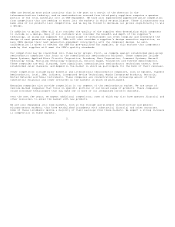Adaptec 2002 Annual Report Download - page 21
Download and view the complete annual report
Please find page 21 of the 2002 Adaptec annual report below. You can navigate through the pages in the report by either clicking on the pages listed below, or by using the keyword search tool below to find specific information within the annual report. Marketing, General and Administrative Expenses
Our marketing, general and administrative, or MG&A, expenses decreased by $26.9 million, or 30%, in 2002
compared to 2001. Of this decrease, $4.2 million was attributable to lower variable sales commissions as a
result of lower revenues. The remainder was attributable to the restructuring and cost reduction programs
implemented in 2001, which reduced our MG&A personnel and related costs by $9.7 million and other MG&A
expenses by $13.0 million compared to 2001.
Our MG&A expenses decreased by $10.3 million, or 10%, in 2001 compared to 2000 due primarily to a $12.0
million reduction in sales commissions resulting from the decline in our revenues. The restructuring
programs implemented in 2001 reduced our MG&A personnel by 30% from the end of 2000, but due to growth in
the latter part of 2000 resulted in only a 3% year−over−year decrease in our MG&A personnel costs. This
decrease in personnel costs combined with the decrease in recruitment costs resulting from less hiring
activity in 2001 was more than offset by increases in the cost of facilities due to the prior year's
expansion.
Acquisitions that we completed during 2000 and accounted for under the purchase
method increased our 2001 MG&A expenses by $1.2 million compared to 2000.
Amortization of Deferred Stock Compensation
We recorded a non−cash charge of $2.8 million for amortization of deferred stock compensation in 2002
compared to a non−cash charge of $41.2 million in 2001 and $36.3 million in 2000.
Deferred stock compensation charges decreased by $38.4 million in 2002 compared to 2001 because we
accelerated vesting for certain employees terminated as part of our 2001 restructurings. This acceleration
of vesting also resulted in higher charges in 2001 compared to 2000.
Impairment of Property and Equipment
In 2002, we recorded an impairment charge of $1.8 million reflecting a reduction in the estimated fair value
of a product tester. This equipment was removed from service because lower manufacturing and product
development volumes resulted in excess product tester capacity.
There were no impairments of property and equipment in 2001 or 2000, other than
those assets impaired as a result of our 2001 restructurings as described below.
Restructuring Costs and other Special Charges
On January 16, 2003, we announced that we are undertaking a further corporate restructuring to further
reduce our operating expenses. The restructuring plan includes the termination of approximately 175
employees and the closure of design centers in Maryland, Ireland and India. We expect that we will record a
restructuring charge for workforce reduction, facility lease costs and related asset impairments as these
liabilities will be incurred in the first and second quarters of 2003.
During the year, we paid out $27.5 million in connection with October 2001 restructuring activities. See
"Critical Accounting Policies and Significant Estimates".
20
























